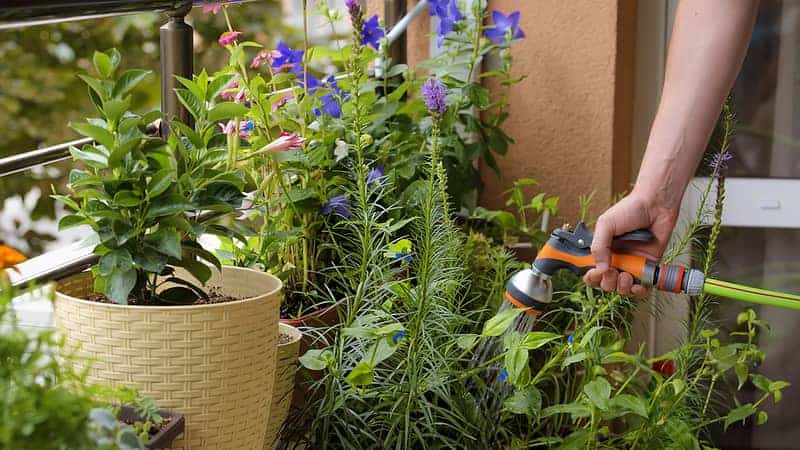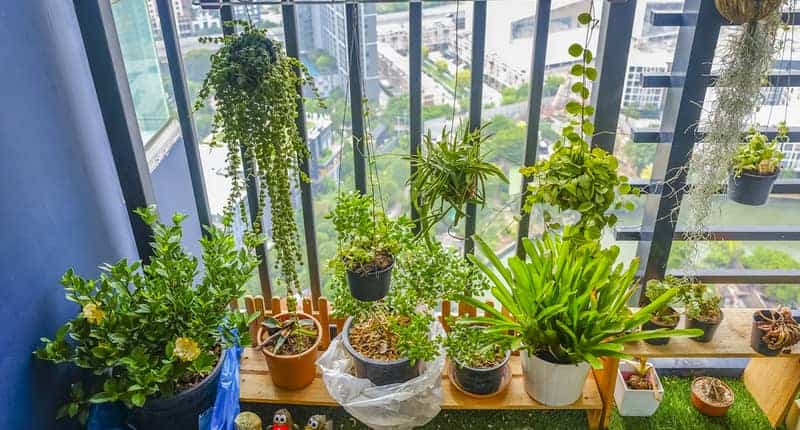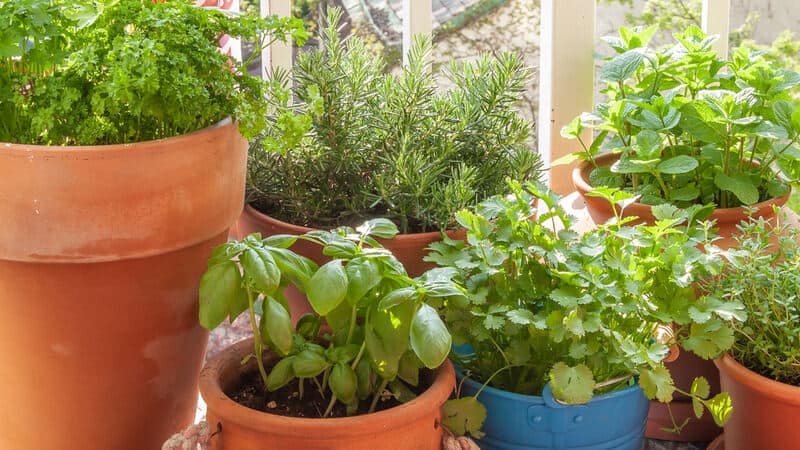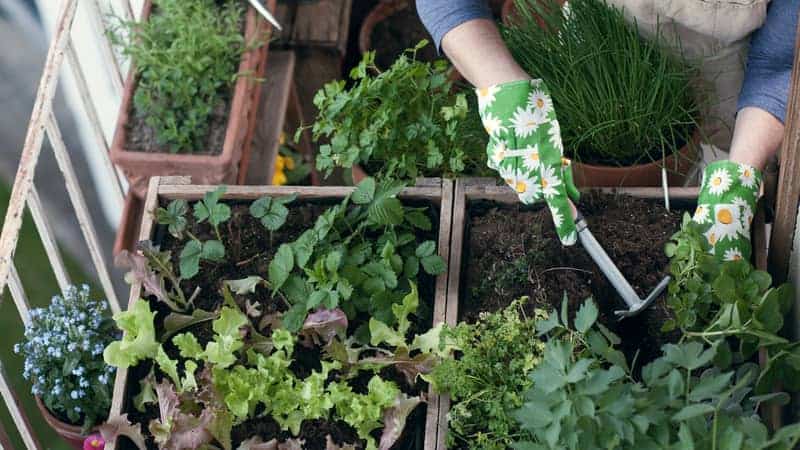Gardening is one of the best pastimes. Getting your hands dirty can benefit both your mental and physical health. Just imagine how it feels seeing your flowers bloom for the first time – isn’t it magical?
It is… or it would be, if you had any space. Fortunately, for those of us who live in rentals and small houses, we don’t have to miss out on plant parenthood.
Meet the balcony garden – maximising garden possibilities in minimal space. Balcony gardens are perfect for those living in city centre apartments or rental homes, or for those who just want a small plant patch with easy access.
The garden ideas for your balcony are as endless as your imagination – with some caveats, of course! Grow your own mini-jungle or keep it simple and minimalist. Keep it low-maintenance or plant edible crops. You can even have a little row of succulents and it’ll still count.
Before you start piling on the plants, though, there are a few things to keep in mind for your apartment balcony garden.
Building A Balcony Garden

How do you turn a balcony into a garden? There are several factors that go into balcony garden design and complexity.
Fortunately, there’s a plant for every space, so once you’ve evaluated the conditions of your balcony, you can start planning!
How much space do you need for a balcony garden?
The most important question when planning a balcony garden is this: How big is your balcony?
The size of your balcony floor will determine how big or small your plants will be, and how you can lay them out. A more vertical space will necessitate vertical gardening, while a wide area will let you space your pots out more.
Even if you have a tiny balcony, there are ways to start a garden. You can grow plants in hanging baskets, or make use of your window sill or balcony railing!
How much sunlight should it get?

The amount of direct sunlight — direct, mind you! — your balcony receives will affect the types of plants you cultivate. Take into account how many hours of sunlight your balcony gets, and if anything obstructs the sun to create shade (buildings, walls, and outdoor plants are some examples).
Also, make sure to check throughout all seasons — most balconies won’t be getting the same amount of sunlight in summer as in winter.
To time the amount of sunlight, either use a manual timer or a sun calculator tool. Keep a note handy so you know how long the sun lasts — and where it hits, too!
Some plants like full sun, while others prefer shade. Some need shelter from the afternoon sun. Check with the nursery or plant shop to make sure you’re getting a leafy friend appropriate for your space!
What’s the climate like?
Balconies can get pretty hot, with the sun reflecting off walls and windows. Your floor material can absorb heat in the summer or cold in the winter, which not all plants like.
Their semi-enclosed nature means a balcony forms its own ‘microclimate’, so you should check with a digital thermometer how hot or cold it can get. Not every plant can withstand all temperatures.
Does wind affect a balcony garden?
As with heat and cold, each plant reacts differently to the wind. Some plants can tolerate a breeze, but others need to be kept away.
There are ways to create windbreaks to shelter your plants, such as using large plants or outdoor décor to shield them. But if it gets gusty out there, you may want to pick a leafy friend that’s hardy!
One other disadvantage of wind is that it dries out your plants quickly. You can compensate by creating a watering system, or just water more often — but not too much, or your plants will drown.
How to water a balcony garden

Indoors, outdoors, or on balconies — watering plants is always a tricky business.
You don’t want to overwater and drown your leafy friends, but you don’t want them to dry out either.
There are several ways to water plants in a balcony garden, such as:
- Manual watering
- Drip irrigation system
- Self-watering pots
Which system you use will depend on which plants you pick. Some plants are drought-tolerant (lavender, lemongrass, and ferns are good options), while others need moist soil to thrive.
Figure out what kind of system you can set up on your balcony first, then pick your plants.
What containers should I use?

If you’ve ever tried to lift terracotta pots, you’ll know those things are heavy. For those of you who live high up, getting the pot to your apartment will already be a pain.
Consider what weight your balcony can hold, and see if you can’t pick resin or plastic pots instead.
Other options for containers include hanging pots, or baskets that you can stack or place on a vertical shelf.
You could even get a raised container garden, which is optimised for gardening in a small space!
What potting mix should I use?
While most potted plants can thrive on general-use potting mix, some may have special requirements.
Consult your local nursery or gardening service regarding what soil to use for which plant.
How to care for balcony garden plants

Each plant has different needs, which is something to keep in mind.
How much time and diligence can you devote to them? Will you put in the effort for flowers, or do you prefer low-maintenance herbs? Are you frequently at home or will your plants be alone for long periods of time?
There are ways to design a system so you can minimise the attention you give your plants — or just hire a professional gardening service to maintain them for you!
The Best Types of Balcony Plants
All right – that’s a lot of information already that can feel overwhelming. We can’t blame you, but it is important! And once you’ve considered your balcony garden condition, it’s time for the most fun part: picking plants.
With such a small space, it might feel like your options are limited. But rest assured that no matter your balcony conditions, there will almost always be a plant out there that you can care for.
Here’s a brief rundown of several types of plants you can have in your balcony garden!
Succulents

The classic choice for low-maintenance gardeners, or those of us with brown thumbs.
Succulents are great if you can’t water often (or forget — it happens), or if your balcony gets plenty of sun.
There are plenty of options for succulents, in all manner of colours and sizes, so just pick your favourites and set them out in a cute row.
Herbs and spices

These are perfect for cooking, or for gardeners who prefer simpler plants to care for. They’re great for a tiny balcony since you can keep them in small pots, or in a planter on your balcony railing.
Basil, rosemary, lavender, mint, parsley, native citrus, lemon myrtle, and mustard are excellent choices for a gardener with limited space.
Vegetable garden
Yes, you can still grow fruits and vegetables in a balcony garden!
They’ll need more attention than in a regular garden, but they’re well worth the effort once they’re ready for harvest.
Some options for edible plants include:
- Fruits: raspberry, strawberries, blueberries, and lemons. You can even check for dwarf varieties!
- Salad vegetables: baby cos, rocket, bok choy (and other Asian greens), silver beet, kale, spinach, even spring onions and celery.
- Food crops: tomato, cucumber, eggplant, capsicum, and if you like the heat, chilli.
One advantage of having a vegetable garden is that you can save money. Instead of popping down to the shops for some rocket, you can have some right on your balcony garden to use.
Ornamentals

You can absolutely grow flowering plants on a balcony — just make sure you have the right conditions.
Ornamentals can be sensitive to things like heat or soil type, so prep beforehand and choose wisely.
If you’re a fan of flowers, you can grow plants like begonias, pansies, hydrangeas, and even marigolds.
Hanging plants
If you have a rack or a rafter to take advantage of, or can add hooks to the ceiling, then hanging plants make an excellent accent to any space.
Choose from options like bacopa, verbena, hanging fuchsia, spider plants, devil’s ivy, philodendrons, and even ferns.
Add some aesthetic with hanging pots – just install hooks. Just make sure they’re not large pots or they could post a safety hazard to anyone walking underneath.
Challenges To Balcony Gardening

Of course, balcony gardening — like regular gardening — isn’t without its obstacles.
There are certain challenges you’ll face, so keep these in mind if you’re going to add some plant friends to your balcony!
Floor space
Balconies have limited floor space, especially if you want somewhere to sit.
Your balcony garden design needs to take into account how much space is available, because that will determine the size of your individual pots or containers.
You may not be able to fit as many plants as you want, so learn to compromise!
Weather
Excess sunlight, frost, and strong winds will all pose difficulties for your balcony garden, and should be considered carefully.
Wind is especially frustrating for those living on the upper floors of tall buildings.
Either work with the weather in your zone (and the microclimate generated on your balcony) or plan around it.
Water overflow
Watering is tricky enough without having to consider where it goes — but you’ve got to!
Water overflow comes from excess water when watering plants, and it can cause rot on wood floors or trickle down to your downstairs neighbour (or even people on the street!).
You’ll need to include catching systems in all your pots and planters, such as trays.
(And make sure to clean them regularly — stagnant water is a health hazard!)
Wildlife
If you’re growing edible plants, be mindful of any uninvited guests!
Your fruits could attract birds and insects, and not all of them might be welcome.
You can cover your plants in mesh or a similar cover so you don’t block access to sun and light, but still keep them safe from any curious creatures looking for a snack.
Happy Gardening!
Just like regular gardening, starting a balcony garden takes quite a bit of work.
But if you plan ahead and take all factors into consideration, you’ll do just fine – thumbs and all.
Collect your plants, pots, and other provisions, and you’ll be well on your way to the balcony garden design of your dreams.
After that, it’s just a matter of not forgetting to water your plants!

